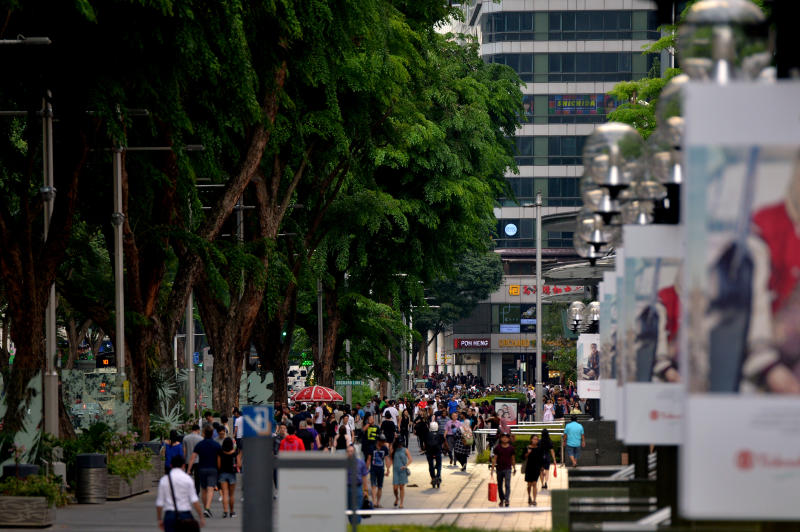URA unveils plan to revitalise Orchard Road, CBD
Sign up now: Get ST's newsletters delivered to your inbox

The 2.4km Orchard Road may see a car-free portion to connect green spaces, as well as new retail concepts, attractions, entertainment options and events.
PHOTO: ST FILE
Derek Wong
Follow topic:
SINGAPORE - Shoppers in Orchard Road may one day find themselves in a lush urban corridor that connects to the Singapore Botanic Gardens and Fort Canning Park, according to plans to rejuvenate the central area.
The Urban Redevelopment Authority's (URA) Draft Master Plan, which was released on Wednesday (March 27), includes other initiatives to revitalise the central area, such as tapping vacant state properties in the Central Business District (CBD) for short-term use to bring greater footfall.
The plan also includes the introduction of two schemes to incentivise developers to convert ageing developments to other purposes such as hotels and residential use.
"Increased global competition, changing trends and lifestyle aspirations mean that our city centre needs to maintain its competitive edge and dynamism through continued growth and rejuvenation," said the URA in a statement.
To work towards that, Orchard Road will be divided into four sub-precincts, each offering a different experience.
The 2.4km stretch may also see a car-free portion to connect green spaces, as well as new retail concepts, attractions, entertainment options and events.
A solution to generate more vibrancy in the CBD is to tap vacant state properties, URA chief planner Hwang Yu-Ning told the media in an earlier briefing on Monday.
These buildings can be used to test-bed new ideas and events.
"The adaptive reuse of existing buildings is about creating opportunities for new users to go into these old buildings that are not yet ready for rejuvenation or redevelopment," she said.
"This could add new interest to different precincts and bring new life to the places."
Some of these vacant buildings are in Maxwell Road and Sultan Gate.
The public can contribute ideas on how to utilise such spaces in the short term on the URA website.
The URA also launched two schemes on Wednesday designed to encourage the redevelopment of older buildings in strategic areas.
The first is the CBD Incentive Scheme, which will give developers a higher gross plot ratio - the permissible development intensity of a land parcel - to encourage them to turn older offices into mixed-use buildings.
The scheme will kick in when the Master Plan is gazetted, which is expected to be later this year.
The other is the Strategic Development Incentive Scheme (SDI Scheme), which took effect on Wednesday.
Under this scheme, developments islandwide may be able to increase their gross plot ratio or attain flexibility on other development controls if they have innovative proposals that transform the precinct.
Such ideas include the provision of high-quality public spaces, car-lite measures and conservation efforts, for example.
To qualify, the buildings must have a minimum age of 20 years from the date of the last temporary occupation permit.
Submissions will be assessed on a case-by-case basis.
Mr Jason Leow, president (Asia and retail) of CapitaLand Group, which owns and manages a network of properties in the central area, said it is looking into how to work with the authorities to create a more vibrant city-state amid the introduction of the new schemes.
He called the Draft Master Plan "a positive move in promoting ground-up ownership of and private participation in the urban rejuvenation of Singapore's built environment".
Mr Nicholas Mak, executive director of property consultancy ZACD Group, said owners of ageing retail malls outside the central area may be attracted to the SDI Scheme, as these developments face dwindling footfall due to changing consumer habits amid a rising e-commerce industry.
"These owners are likely to welcome incentives which encourage redevelopment and possible conversion of uses to inject more life and vibrancy in the area," he said.
The two schemes may lead to unintended results, according to Ms Christine Li, senior director and head of research at property firm Cushman & Wakefield.
For example, she said, the CBD Incentive Scheme may indirectly cause CBD office rents to rise.
"Given that there could be a wave of redevelopments into residential and hotel segments to tap the CBD Incentive Scheme, office supply in the medium term could be even tighter if there are more conversions of office developments into residential and hotels," she said.
Efforts are already underway to improve mobility in the CBD.
Government agencies are exploring transforming Robinson Road into a transit-priority corridor, which means the stretch will be reserved for public transport, cycling paths and pedestrian walkways.
By 2021, more than 5km of cycling paths will also be added to the existing 22km network in the central area.

